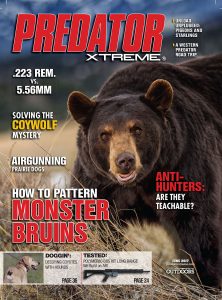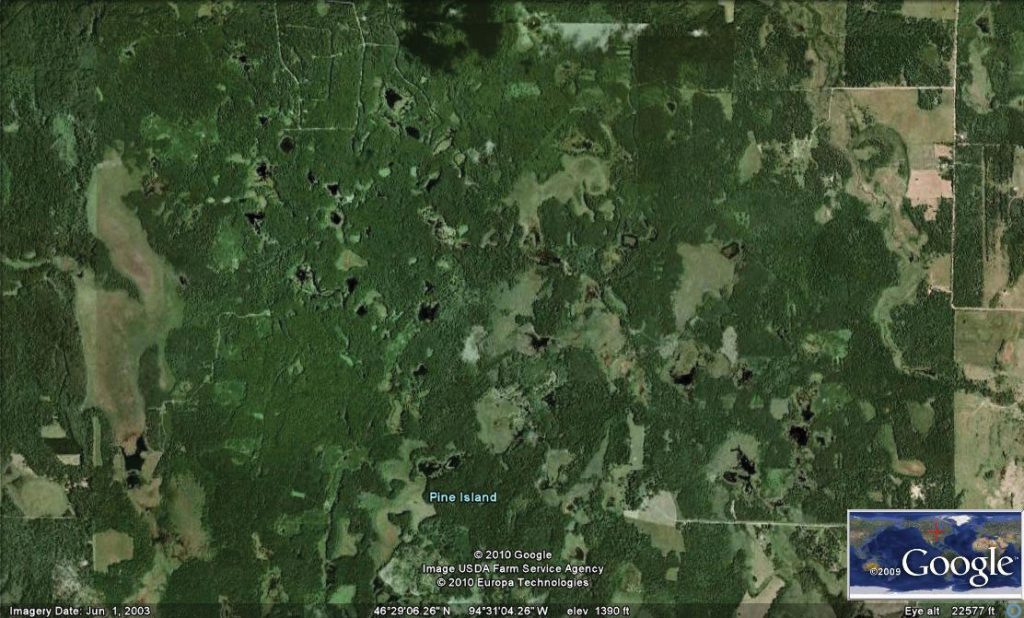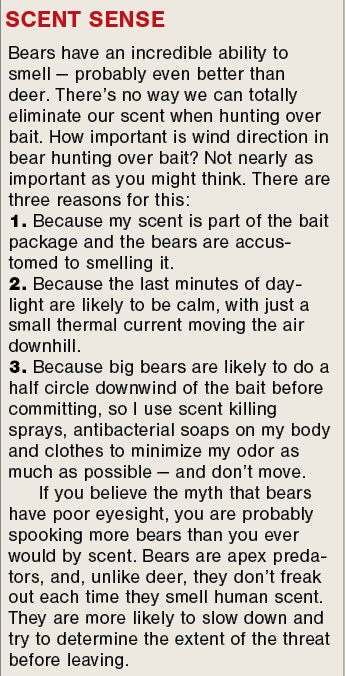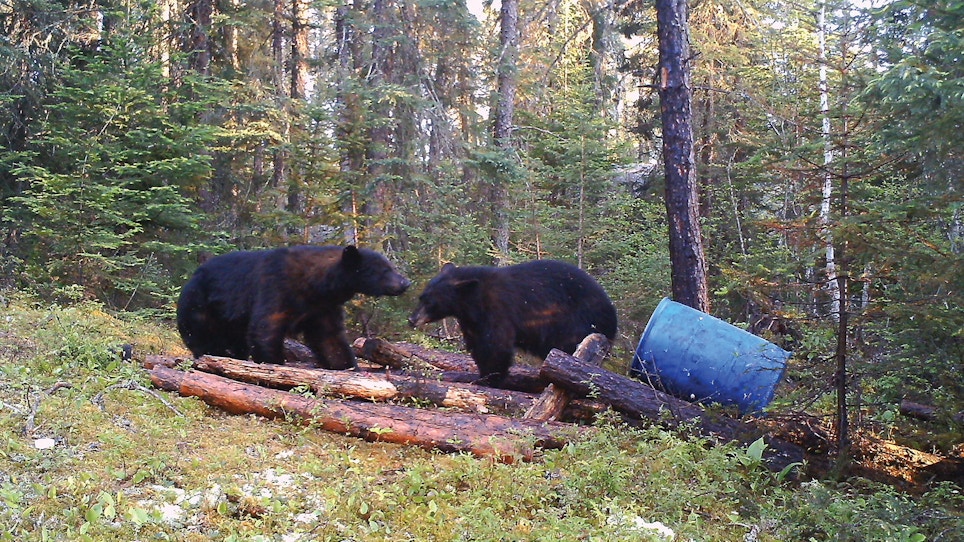The bear cautiously moving through the bush 30 yards from me was very familiar. True, I had never seen this bear in person, but I recognized him from a couple dozen scouting camera photos. Here in Minnesota, where the average bear taken is less than three years old and averages about 150 pounds, this bruiser was an anomaly. Seeing a mature male bear in person during the daylight didn’t happen by accident.
Daylight was fading fast. My heart pounded as the bear circled to smell where I had approached the bait site a few hours earlier. He spent a moment smelling my entry trail, then disappeared.
 A moment later he reappeared at the edge of the small bait clearing and sat down on his haunches. I said a silent prayer that he would commit to the bait within the last 10 minutes of legal shooting light. My prayer was answered. When that adrenaline-charged 10 minutes ended, I was carefully listening for a death moan while I gathered up my gear for what would be a short tracking job.
A moment later he reappeared at the edge of the small bait clearing and sat down on his haunches. I said a silent prayer that he would commit to the bait within the last 10 minutes of legal shooting light. My prayer was answered. When that adrenaline-charged 10 minutes ended, I was carefully listening for a death moan while I gathered up my gear for what would be a short tracking job.
That 375-pound bruin is a trophy anywhere, but even more so in the upper Midwest, where human activity and hunting pressure quickly teaches the bears to avoid making mistakes. It was the result of a carefully thought-out strategy to make the bear feel as comfortable as possible approaching the bait in daylight. In fact, I had moved the bait 40 yards based on what I had learned from watching other bears approach the site.
Pressured bears aren’t like the bears of the Canadian wilderness, where they walk into a bait site like they own it. You bump a bear off a bait in the Manitoba wilderness and he might be back in 15 minutes. You bump a bear off a bait site on public land in Minnesota, Michigan or Wisconsin and you may never see it in the daylight again.
That’s why the exact right location can significantly increase your odds of bagging a mature bear. Let’s start wide and then narrow it down, I’ll show you what I have learned from experience in hunting black bears across North America.
RELATED: Hunting North American Black Bears
Terrain Features
I put out a lot of sites when I started baiting bears. My idea was to figure out which ones were good and drop the rest. It worked pretty well, but it took quite a few years to flesh it out. I might put out 10 baits, but by the end of the season I would be down to two that were really good. The next year I would add more, just keeping the best ones. After eight to 10 years, I had a handful of baits that were consistently good, year after year.
When analyzing why these baits produced, I discovered that they all had a couple things in common. I carefully looked at them using online aerial photography and some things began to jump out at me. I knew it was key to get the bears on my bait quickly and keep them there because of the number of other bear baiters in the area. I discovered that my best baits were those which had land features that directed bear travel into the bait site itself.

A trained eye can spot natural funnels and pinch points near water. The key is getting out there and walking to find a specific spot.
In a way, it’s like looking for funnels and pinch points to hunt for deer during the rut. Here in Minnesota, we are allowed to set baits out about two weeks before opening day of bear season. That means we need the bears to find our baits really fast. Good, quality spray lures help, but putting a bait right where a roving bear is likely to encounter your sweet smell is critical.
Things that funnel bear movements can be the edges of rivers and lakes, cliffs, heavily traveled highways, terrain features that naturally guide them. Areas that offer natural foods are also excellent. Raspberries, chokecherries, oaks and hazelnuts, beaver ponds, you get the idea. I have also found that mature male bears are more likely to follow the top of a ridge than the bottom. Look at it this way: if you were 400 pounds would you rather push your way through the thickets along a creekbottom or walk a ridge where the saplings give you cover but don’t pull at your legs on every step?
When examining the features of my most consistent baits, the biggest “aha!” moment for me was the surprising value of water. All of my best baits were located within 200 yards of some source of water!
The Importance Of Water
I now realize that bears spend a huge amount of time in and around water. Think about it, you are bear hunting in the spring and fall when the weather is warm and the bears are covered with a thick, black coat and a layer of fat. They need cool places to relax during hot days. They spend a lot of time lying in pools of water — swamps, creeks, lakeshores, beaver ponds and boggy areas.
RELATED: 7 Hard-Earned Bear Hunting Tips
And they need to drink a lot of water as well. During the late summer, they are consuming huge quantities of high-carbohydrate foods and they need to intake gallons of water to help with digestion. The proximity to water is one of the most critical aspects of choosing a baiting location.
I also discovered another critical water-related factor. It seems almost silly that I overlooked it for so long, but many bear hunters make the same mistake I did. A bear spends his day at the water, so when he rises in the late afternoon from a growling stomach, he stretches and decides to go get a bite to eat. The closer that food is to the water, the more likely he is to arrive at the bait before dark. It’s a very simple concept that’s often overlooked; a bear may take an hour to go 100 yards. And the sun is sinking lower and lower through that hour.
I now put my bait in areas where a bear can fill his belly, then go sleep it off nearby so he is close when he gets hungry again. A cool, swampy area or stream provides him a place to sleep and lounge around during the daytime.
Corridors Of Cover
The second factor in this locational challenge comes from the fact that heavily hunted bears are reluctant to cross open areas during daylight. Mature bears rarely walk through open-canopy at any time, but many simply will not cross these areas until the darkness gives them a feeling of safety. They much prefer the security of ground cover to conceal their movements.
For this reason, I choose an area with lots of ground cover in which to place the bait site itself; and, just as importantly, I look for a travel corridor of cover that allows the bears to get to the site without exposing themselves. The cover doesn’t have to be very tall. Bears actually seem to prefer brush of a height that is just over their back. They love these areas.
I can’t prove it, but I have theorized that they like to move through cover that conceals them when walking and also those which they can easily see over when they stand up.
Keep in mind that placing the bait within cover also allows me to enter and exit the bait site with minimal disturbance. It’s easy to overlook the importance of quiet, secluded access to the bait both for baiting on the sly and sneaking in and out when the time to hunt comes.
Now that we have a pretty good idea of the components that separate a great bait site from the average, let’s narrow it down to the tiny footprint of real estate where you can kill a mature bear each time you draw a tag.
The Exact Spot
Remember that big bear I mentioned at the beginning of this story? I noticed that he would only appear on camera just after dark, so I moved the bait about 40 yards uphill away from the edge of the beaver pond into an area with thick, leafy ground cover. He simply wouldn’t enter the old spot until it was fully dark. Moving the bait just a short distance turned him from a wise old bear into a bear rug.
My ideal bait site is a small clearing surrounded by cover. By small, I mean small enough that the bear is never more than two to three leaps from the dense brush. If I can’t find one in the right spot, I’ll make one. I cleared out enough brush to have an open-shot opportunity around the bait. That’s all the clearing needed. Typically, my sites will be shaped kind of like a light bulb with the bait on the big end and the stand on the small end.
I like my stand to have plenty of background cover to break up my outline. I take prevailing wind direction into account whenever possible, but wind is not as critical as remaining concealed. Mature bears will often move to your entry path and smell your ground scent. They know how old it is and will react accordingly. If you normally bait at noon, but you arrive for your hunt at 4:00, you’re throwing that bear a curveball that might just cause him to back off until dark. Big bears take few chances.
So there you have a basic rundown of my thoughts in placing bear baits. I realize full well that some people may presume that I am overthinking this. We all know of someone who dumped a bucket of pastries in the woods and ended up shooting a bear there. But if you want to consistently bring mature bears to a bait site during legal shooting hours, you need to be a lot more intentional about your choice of location. I trust my observations will help you increase your odds of bagging a big old bear.






